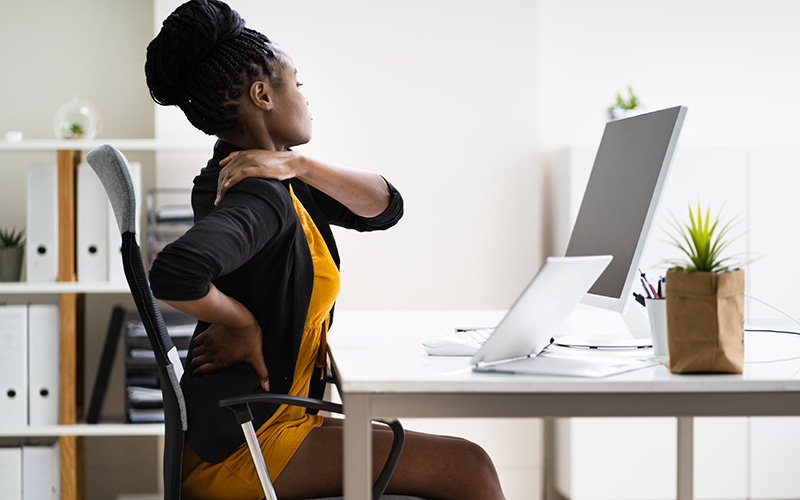
As more people are working from home, increased complaints of tightness and soreness are brought up in the clinic. Many recognize that their computer setup at home is just not the same as at the office. Though we may not be inclined to go out and buy new chairs, desks, and computer screens immediately, there are things we can do to help reduce discomfort while working at home.
Posture is key and begins with correct positioning of your pelvis, back, neck, shoulder, through the elbow and wrist. If any of these regions are not aligned in neutral, it can put increased stress on specific tissue groups and likely affect neighboring joints. This leads to increased tension and aches in the body. Some postural tips to regard are listed below.
- Begin by considering your chair. Your chair should allow your feet to be flat on the ground, should enable good back support, and a 100-110 degree hip angle, meaning your are slightly tilted back (UCLA, 2020). It is okay to be slightly tilted back for a more relaxed position and to take stress off the spine.
- Think of the armrests of your chair. Armrests should be at a height to allow your arms to rest naturally by your side (Dorsey, 2020). Your shoulder should not hike-up nor cause you to tilt to the side. The keyboard and mouse should be within a comfortable reach, allowing for 90-110 degree elbow angle (UCLA, 2020).
- A monitor should be placed at a height and position that does not cause twisting of the neck and body, nor tilting down or up at the neck (Hedge, 2015). Position the monitor and keyboard directly in front of your body.
There are many products on the market designed to help posture. For pelvis and back support, consider using lumbar support pillows or a core balance disk. For forearm and wrist support, you may want to look into a vertical mouse, padded mouse pad, or an ergonomic keyboard. Talk to your therapist about which products are best for you.
Next, stretch of course! Take rest breaks and stretch. In general, when choosing stretches that may benefit you, consider the position you are in all day while seated at the computer. Now think of the opposite pose, and stretch in this position. For instance, if your elbows are bent while using the computer, extend the elbows. If your hands are palm down the majority of the day, turn your palms up. Rotate and tilt your head, stand up, etc. Take a look at Proactive’s other article, titled Simple Stretches During COVID Times for additional full body stretches.
Some other tips to consider are lighting, keyboard shortcuts, a designated work area and rest breaks. To prevent a glare on your computer screen, it is recommended to place the computer perpendicular to windows (UC Berkeley, n.d.). Secondly, using keyboard shortcuts will cause you to break-up those extended positions of holding and clicking the computer mouse. Next, a designated work area can allow for appropriate desk and chair settings and less overall stress. Vary your posture as work tasks change, such as standing at the kitchen counter when hand writing notes (Dorsey, 2020) or take a walk around the home while on the phone. And do not forget to take multiple breaks throughout the work day.
For more information, including correct postural positioning, appropriate stretches or computer accessories, contact a local occupational or physical therapist.
References
Dorsey, J. (2020). Home Office Ergonomic Tips. American Occupational Therapy Association. https://www.aota.org/~/media/Corporate/Files/Practice/Manage/Home-Office-Ergonomics-Tips.pdf
Hedge, A. (2015). Ergonomic Guidelines for arranging a Computer Workstation – 10 steps for users. Cornell University. http://ergo.human.cornell.edu/ergoguide.html
UC Berkeley (n.d.). Ergonomic Tips for Working at Home. Be Well at Work: Faculty/Staff Ergonomics. https://uhs.berkeley.edu/sites/default/files/ergonomics_tips_for_working_at_home.pdf
UCLA. (2020). Postural Guide. University of California. https://www.ergonomics.ucla.edu/office-ergonomics/postural-guide.

